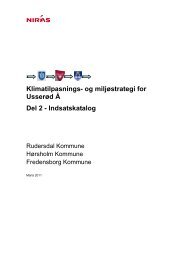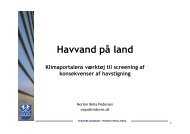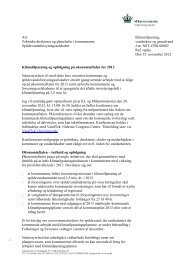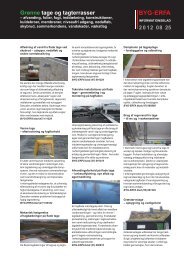Mapping climate change - barriers and opportunities for action
Mapping climate change - barriers and opportunities for action
Mapping climate change - barriers and opportunities for action
You also want an ePaper? Increase the reach of your titles
YUMPU automatically turns print PDFs into web optimized ePapers that Google loves.
generation of national water plans is to be submitted by the end of 2015. New knowledge will be<br />
able to underpin the implementation of <strong>climate</strong> <strong>change</strong> adaptation in water planning.<br />
For nature on l<strong>and</strong> there has been no complete mapping of the possibilities to adapt to <strong>climate</strong><br />
<strong>change</strong>. It should be assessed whether existing regulation in this area is adequate to support <strong>climate</strong><br />
<strong>change</strong> adaptation. In this connection, it would be relevant to apply, <strong>and</strong> possibly to amend, a<br />
number of acts, including the nature protection act, the environmental targets act <strong>and</strong> the planning<br />
act. As the need <strong>for</strong> knowledge is being gradually met, it would be relevant to disseminate new<br />
knowledge to various nature administrators such as l<strong>and</strong> owners, municipalities <strong>and</strong> authorities at<br />
state level. It is essential to remember that nature can be used in general <strong>climate</strong> <strong>change</strong> adaptation<br />
ef<strong>for</strong>ts to cushion the effects of <strong>climate</strong> <strong>change</strong>, e.g. to serve as a buffer in situations involving<br />
heavy rainfall or to prevent nutrient run-off.<br />
Health<br />
In terms of human health, <strong>climate</strong> <strong>change</strong> adaptation is primarily about collecting knowledge <strong>and</strong><br />
providing consultancy about risks to authorities, health-care staff <strong>and</strong> individuals. The Danish<br />
Health <strong>and</strong> Medicines Authority is preparing in<strong>for</strong>mation material <strong>and</strong> providing consultancy on an<br />
ongoing basis about the possible negative effects of <strong>climate</strong> <strong>change</strong>, e.g. about mould, how to<br />
include extreme weather in public health emergency response plans, <strong>and</strong> about precautionary<br />
measures during warm spells <strong>and</strong> heatwaves. The <strong>for</strong>ward-looking ef<strong>for</strong>ts will mostly be a<br />
continuation of initiatives that have already been launched. Finally, it may be relevant to make<br />
greater use of health impact assessments of potential alternative approaches in <strong>climate</strong> <strong>change</strong><br />
adaptation in order to improve decision-making.<br />
Emergency preparedness<br />
The government's report on emergency preparedness (May 2010) points out that in future the<br />
Danish fire <strong>and</strong> rescue service must be prepared to mitigate the follow-on effects of several <strong>climate</strong>related<br />
events such as hurricanes/storms, heavy precipitation, cloudbursts, storm surges, <strong>and</strong><br />
extreme water levels. On the basis of experience from <strong>climate</strong>-related events since 2007, it is likely<br />
that equipment to tackle such events will continue to be in dem<strong>and</strong> in the future. The size of the<br />
investments required depends e.g. on whether there are enough preventive measures in other<br />
sectors, as well as on future organisation <strong>and</strong> coordination of the rescue preparedness services at<br />
local <strong>and</strong> central-government levels. The closer the collaboration <strong>and</strong> coordination of equipment<br />
procurement <strong>and</strong> resource use across local <strong>and</strong> central-government levels, the better <strong>and</strong> more costeffectively<br />
the effects of <strong>climate</strong> <strong>change</strong> can be managed.<br />
Insurance<br />
So far, insurance companies have been able to recover greater indemnification costs due to <strong>climate</strong><br />
events via increases in premiums <strong>and</strong> reinsurance schemes. Insurance companies are widely<br />
equipped with the necessary tools to prepare <strong>for</strong> <strong>climate</strong> <strong>change</strong> by adjusting coverage <strong>and</strong><br />
premiums. Furthermore, the insurance industry has already launched initiatives to ex<strong>change</strong> data<br />
with public authorities so that the insurance companies will be able to adapt coverage <strong>and</strong> premiums<br />
to risks, <strong>and</strong> so that the municipalities <strong>and</strong> individual citizens can reduce their exposure to <strong>climate</strong><br />
<strong>change</strong>. However, it is important to monitor the insurance industry in terms of citizens <strong>and</strong><br />
enterprises that in future will not be able to take out insurance against water damage.<br />
Spatial planning<br />
Spatial planning is an effective instrument of control which can contribute to reducing or<br />
eliminating negative effects, as well as exploiting positive effects, of <strong>climate</strong> <strong>change</strong> in a number of<br />
10

















